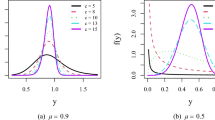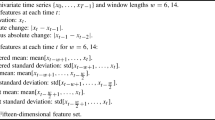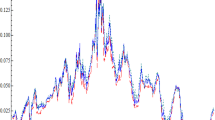Abstract
This paper proposes a new approach to estimate the overnight volatility of an individual stock return. Since markets generally do not trade during the overnight period, measures of realized volatility cannot be computed on a “high-frequency” basis. Some studies have resorted to using the square overnight return as a proxy for the overnight realized volatility, but this measure is typically very noisy. The new estimator of the overnight volatility proposed is obtained using the generalized dynamic factor model. The performance of the new proxy is examined using simulated data. This is found to perform better than the squared overnight return. Empirical analysis of the S&P100 constituents confirms the potential of this proxy.
Similar content being viewed by others
References
Abramowitz M., Stegun I.: Handbook of Mathematical Functions. Dover, New York (1964)
Ahoniemi K., Lanne M.: (2010) Realized volatility and overnight returns, Bank of Finland Research, Discussion Papers 19/2010
Andersen T., Bollerslev T.: Answering the skeptics: yes, standard volatility models do provide accurate forecasts. Int. Econ. Rev. 39, 885–905 (1998)
Andersen T., Bollerslev T., Diebold X., Ebens H.: The distribution of realized stock return volatility. J. Financ. Econ. 61, 43–76 (2001a)
Andersen T., Bollerslev T., Diebold X., Labys P.: The distribution of realized exchange rate volatility. J. Am. Stat. Assoc. 96, 42–55 (2001b)
Asai M., McAleer M.: Dynamic asymmetric leverage in stochastic volatility models. Econ. Rev. 24, 317–332 (2005)
Barndorff-Nielsen O.E., Shephard N.: Econometric analysis of realized volatility and its use in estimating stochastic volatility models. J. R. Stat. Soc. Ser. B. 64, 253–280 (2002)
Basu S., Meckesheimer S.: Automatic outlier detection for time series: an application to sensor data. Knowl. Inf. Syst. 2, 137–154 (2007)
Black, F.: Studies of stock market volatility changes. In: Proceedings of the American Statistical Association, Business and Economic Statistics Section, pp. 177–181 (1976)
Bollerslev T.: A conditional heteroskedastic time series model for speculative prices and rates of return. Rev. Econ. Stat. 69, 542–547 (1987)
Bollerslev T., Tauchen G., Zhou H.: Expected stock returns and variance risk premia. Rev. Financ. Stud. 22, 4463–4492 (2009)
Boivin, J., Ng, S.: Are more data always better for factor analysis? NBER Working Paper, p. 9829 (2003)
Campbell J.Y., Lettau M., Malkiel B.G., Xu Y.: Have individual stocks become more volatile? An empirical exploration of idiosyncratic risk. J. Finance. 56, 1–43 (2001)
Chamberlain G., Rothschild M.: Arbitrage, factor structure and mean-variance analysis in large asset markets. Econometrica 51, 1281–1304 (1983)
Chan K., Chockalingam M., Lai K.W.L.: Overnight information and intraday trading behavior: evidence from NYSE cross-listed stocks and their local market information. J. Multinatl. Financ. Manag. 10, 495–509 (2000)
Christie A.: The stochastic behavior of common stock variances. J. Financ. Econ. 10, 407–432 (1982)
Connor G., Korajczyk R.A., Linton O.: The common and specific components of dynamic volatility. J. Econ. 132, 231–255 (2006)
Forni M., Hallin M., Lippi M., Reichlin L.: The generalized dynamic factor model: identification and estimation. Rev. Econ. Stat. 82, 540–554 (2000)
Forni M., Hallin M., Lippi M., Reichlin L.: Coincident and leading indicators for the Euro area. Econ. J. 111, 62–85 (2001)
Forni M., Hallin M., Lippi M., Reichlin L.: The generalized dynamic factor model consistency and rates. J. Econ. 119, 231–255 (2004)
Geweke J.: The dynamic factor analysis of economic time series. In: Aigner, D.J., Goldberger, A.S. (eds.) Latent Variables in Socio-Economic Models, North-Holland, Amsterdam (1977)
Hallin M., Liska R.: The generalized dynamic factor model: determining the number of factors. J. Am. Stat. Assoc. 102, 603–617 (2007)
Hansen P.R., Lunde A.: A realized variance for the whole day based on intermittent high-frequency data. J. Financ. Econ. 3, 525–554 (2005)
Jacquier E., Polson N.G., Rossi P.E.: Bayesian analysis of stochastic volatility models with fat-tails and Correlated Errors. J. Econ. 122, 185–212 (2004)
Liesenfeld R., Jung R.: Stochastic volatility models: conditional normality versus heavy-tailed distributions. J. Appl. Econ. 15, 137–160 (2000)
Lopez J.A.: Evaluating the predictive accuracy of volatility models. J. Forecast. 20, 87–109 (2001)
Martens M.: Measuring and forecasting S&P 500 index-futures volatility using high-frequency data. J. Futur. Mark. 22, 497–518 (2002)
Omori Y., Chib S., Shephard N., Nakajima J.: Stochastic volatility with leverage: fast likelihood inference. J. Econ. 140, 425–449 (2007)
Patton A.J.: Data-based ranking of realised volatility estimators. J. Econ. 161, 284–303 (2011)
Sargent T.J., Sims A.C.: Business cycle modeling without pretending to have too much a priori economic theory. In: Sims, A.C. (ed.) New Methods in Business Research, Federal Reserve Bank of Minneapolis, Minneapolis (1977)
Taylor S.: Simulating financial prices. J. Oper. Res. Soc. 6, 567–569 (1989)
Taylor S.: Asset Price Dynamics, Volatility, and Prediction. Princeton University Press, Princeton (2005)
Tsiakas I.: Overnight information and stochastic volatility: a study of European and US stock exchanges. J. Banking Finance. 32, 251–268 (2008)
Yu J.: On leverage in a stochastic volatility model. J. Econ. 127, 165–178 (2005)
Author information
Authors and Affiliations
Corresponding author
Additional information
The views expressed in the note are those of the authors and do not involve the responsibility of the Bank of Italy.
Rights and permissions
About this article
Cite this article
Triacca, U., Focker, F. Estimating overnight volatility of asset returns by using the generalized dynamic factor model approach. Decisions Econ Finan 37, 235–254 (2014). https://doi.org/10.1007/s10203-012-0130-x
Received:
Accepted:
Published:
Issue Date:
DOI: https://doi.org/10.1007/s10203-012-0130-x




